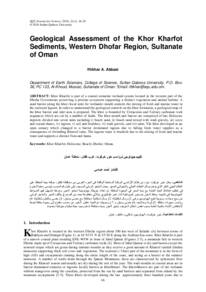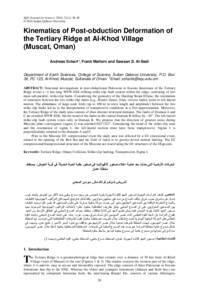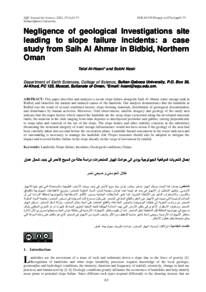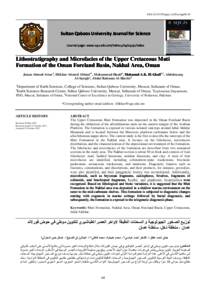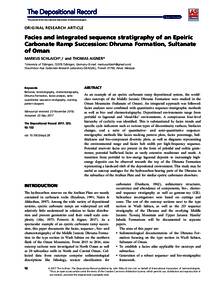وثيقة
An Unconventional neoproterozoic : early cambrian source rock interval in Southern Oman : implications for oil and gas generation.
المعرف
DOI: 10.2113/geoarabia140453
المساهمون
Carpentier, Bernard., مؤلف
Huc, Alain yves., مؤلف
Adam, Pierre., مؤلف
Hanin, Sylvie., مؤلف
Albrecht, Pierre., مؤلف
Wojciak, Patrick., مؤلف
Frewin, Neil L., مؤلف
Al-Ruwehy, Nashwa., مؤلف
الناشر
Gulf Petrolink.
ميلادي
2009-06
اللغة
الأنجليزية
الملخص الإنجليزي
The Neoproterozoic - Early Cambrian Ara intra-salt petroleum system in Oman has been the subject of several studies since the early 1990s, not least because of the exploration success that has accompanied the emergence of the play. As one of the oldest known commercial hydrocarbon systems, the properties of the source organic matter have been of particular interest. The Ara intra-salt hydrocarbon system consists of the Al Shomou Silicilyte, a rock which is composed of pure microcristalline silica, and carbonate colloquially known as "stringers". Both occur as slabs encased in the Ara salt. In the case of the Silicilyte, the slabs can be shown to act both as source rock and reservoir. However, in the case of the carbonate stringers, the association is more ambiguous. A set of rock and oil samples have been selected from different wells penetrating the silicilyte and carbonate stringer plays to better characterize and understand these systems. As far as the sedimentary organic matter is concerned, the Al Shomou Silicilyte domain has an average Total Organic Carbon (TOC) of approximately 4 wt.%. The carbonate-prone domains exhibit rare organic-rich lithofacies (TOC of approximately 2 wt.%) and additional intra-salt shales (TOC of approximately 4 wt.%). The organic matter present in both the Silicilyte and carbonate plays is associated with a hypersaline and anoxic depositional environment, rich in sulfur, and showing very similar chemical signatures (bulk composition, elemental analysis, biomarker content, δ13C). The organic matter associated with these sequences is characterized by an unusual "asphaltenic" nature. Compared to classical fossil organic matter taken at an equivalent maturity level, the organic matter found in the intra-salt silicilyte, shales or carbonates releases a large amount of solvent soluble material, which is very rich in Nitrogen-Sulfur-Oxygen (NSO) compounds, implying a standard Type II-S kerogen. However, the organic matter differs from this classic characterization of kerogen (solvent insoluble) in that a large proportion appears to be a sulfur-rich "soluble" kerogen, which has not been previously described. Independent geochemical parameters (Rock- Eval analysis, kinetic parameters) seem to be consistent with this hypothesis. The thermal maturity of the whole set of samples examined places them in the oil window. Moreover, Thermochemical Sulfate Reduction (TSR) did not occur in these samples. As far as the soluble part is concerned, differences in the molecular (significant molecular variations for norhopanes, secobenzohopanes, carotane, X compounds, thianes, thiolanes) and sulfur isotopic composition were demonstrated, and are assumed to reflect subtle variations in depositional settings between Silicilyte and carbonate stringers. The specific properties of this unconventional organic matter has to be accounted for in the thermal modeling of oil and gas generation. Although the kinetic distribution for kerogen cracking is close to that of a Type II-S kerogen, it is slightly more mono-energetic. A compositional 2-D basin modeling (Ternis 2D) was performed on a cross-section through the South Oman Salt Basin, using specific kinetic parameters measured on this unconventional Neoproterozoic - Early Cambrian kerogen (based on a linear grouping of insoluble kerogen and NSO like "soluble kerogen" kinetic parameters). The gas-to-oil ratio GOR prediction was improved within the silicilyte, when compared to the use of classical parameters assigned to Type II-S kerogen. Finally, the microcrystalline silica mineral matrix of the silicilyte plays is proposed to play a major role in the composition of the fluid, which is expelled and produced by imposing a strong geochromatographic effect on fluids and the retention of polar compounds. The preferential release of aliphatics would lead to the production of oils exhibiting a strong condensate character. This effect has to be considered when modeling the actual composition of the movable fluid in the silicilyte. The significance of the geochromatographic effect is yet to be quantified, but according to available observations, we suggest that this geochromatographic effect could explain the observed API gravity difference between oils produced from silicilyte and carbonate plays.
المجموعة
ISSN
1025-6059
URL المصدر
قالب العنصر
مقالات الدوريات


